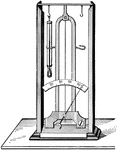Clipart tagged: ‘hygrometer’

Bulb Hygrometer
"This hygrometer consists of two thermometers a and b similar to each other in all respects except that…

Leslies Hygrometer
"Leslie's hygrometer, which is an adaptation of his differential thermometer, is formed by uniting two…

Psychrometer
The psychrometer (showing wet and dry bulb thermometers) is an instrument used for determining the humidity…
Regnaults Hygrometer
"It consists of a glass tube or capsule A, having on the bottom and a little way up a highly polished…

